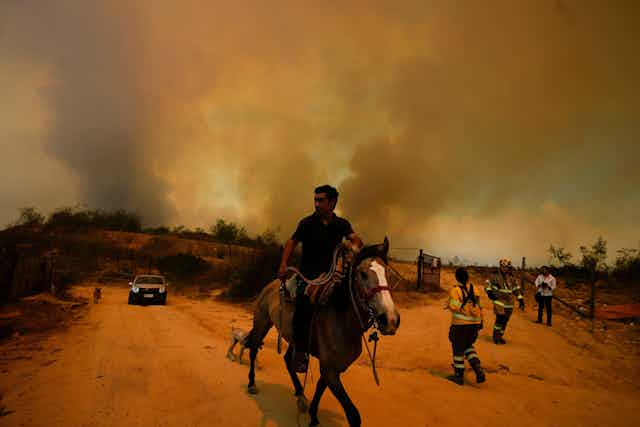Chile has experienced one of the worst fire-related disasters in its history. A series of huge forest fires burned from February 1 to 5, leaving at least 131 people dead – and this number will probably increase as charred bodies are collected and severely injured people die.
But even this is only the tip of the iceberg. There are people with burns, post-traumatic stress and other mental health disorders. Existing diseases have been exacerbated by service interruptions, and people have lost their homes and livelihoods. Also, the long-term effects from smoke inhalation are yet to be seen.
This is not really a “climate disaster”, nor even a “natural disaster”. It is a disaster mainly caused by our decisions and lack of preparation to deal with a more extreme climate hazard. As an academic public health researcher from Chile, I think there are lessons we can learn from these fires.
So, why did things become so deadly?
Fire-prone conditions
The weather, of course, played a role. Meteorological conditions have made Chile very prone to fires this summer, especially in this long-and-thin country’s central region, where it is warm enough for fires yet wet enough for there to be vegetation to burn.

Temperatures were high, above 35°C for more than three days before and during the fires in some places. Conditions were dry on top of a longer-term mega-drought, and relative humidity was low. It was also very windy.
It is very likely that these conditions have been influenced by El Niño, on top of human-induced climate change. However, even when fire danger is extremely high, fires can still be prevented from happening, expanding, or being deadly. But to achieve this, other factors are needed in this formula: social factors.
Formula for a (not natural) perfect disaster
My colleague Ilan Kelman has defined disasters as “where the ability of people to cope with a hazard or its impacts by using their own resources is exceeded”. This is exactly what happened in Chile: a deadly combination of an extreme climate hazard and inadequate social preparation.
In addition, regional authorities and the national government have suggested that some fires were ignited intentionally, as there were four simultaneous outbreaks and a state prosecutor claims that fire accelerants paraffin and benzine have been discovered. No arrests have been made.
The most devastating fires occurred in urbanising areas with significant land-use change, and where urban planning regulation has always been inadequate – leading to houses with no building regulation, and narrow streets with limited access to emergency services when needed.
There was also limited preparation for the expected hot season, either in the form of seasonal public campaigns for heatwaves and fires, or evacuation routes and plans.
Chile’s national early warning system, which sends a mass alert via text, audio and vibration to everyone who uses a compatible mobile device, also faced challenges. Several antennas were affected by the fires and not properly working, so many people did not receive the message on time. And those messages that were sent only said “evacuate”, so many people did not know where to go. This led to traffic jams and bottlenecks, some of which became engulfed in the middle of the fires.
Climate-related hazards shouldn’t turn disastrous
Climate change means it is likely that Chile will be even more prone to huge fires in future. However, the human health risks this poses can be reduced by adequate preparedness and response plans.
Villa Botania, near the city of Quilpué in central Chile, emerged from these fires as an interesting example to learn from. This little village was surrounded by flames but was almost unaffected.
That’s because residents were prepared. A community-led project had managed waste and controlled vegetation and weeds, to ensure there was less flammable material when a fire passed by. Villa Botania demonstrated that a climate-related hazard does not always end in a massive human disaster, and lessons can be learned from this.
Chile recently created a national policy on disaster risk reduction, but it still needs to factor disaster risk and climate change into its planning regulations. This can save lives, as shown by the success since the 1970s of anti-seismic building regulations in this earthquake-prone country.
In a changing climate, we need to prepare the systems that prevent a disaster from occurring in the first place. This is sometimes forgotten, as most resources go to the response phase once it has occurred. However, Chile’s recent fires have again demonstrated that the twin threat of changing climate and inadequate social preparedness poses a serious danger to the health and wellbeing of many people.

Don’t have time to read about climate change as much as you’d like?
Get a weekly roundup in your inbox instead. Every Wednesday, The Conversation’s environment editor writes Imagine, a short email that goes a little deeper into just one climate issue. Join the 30,000+ readers who’ve subscribed so far.

